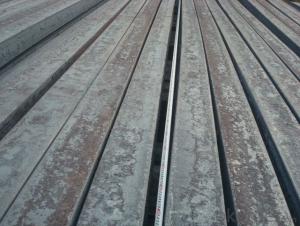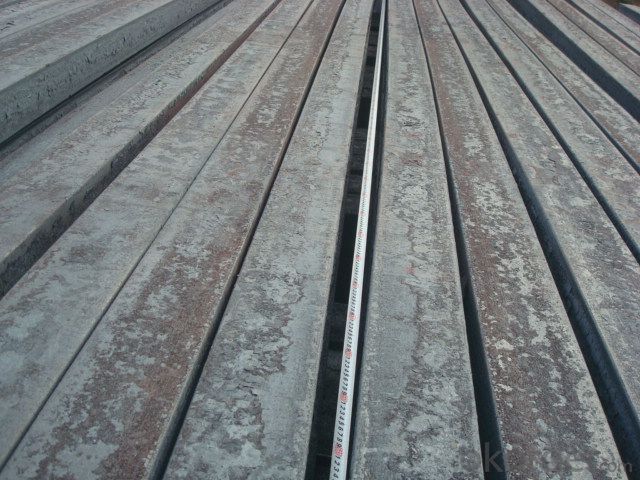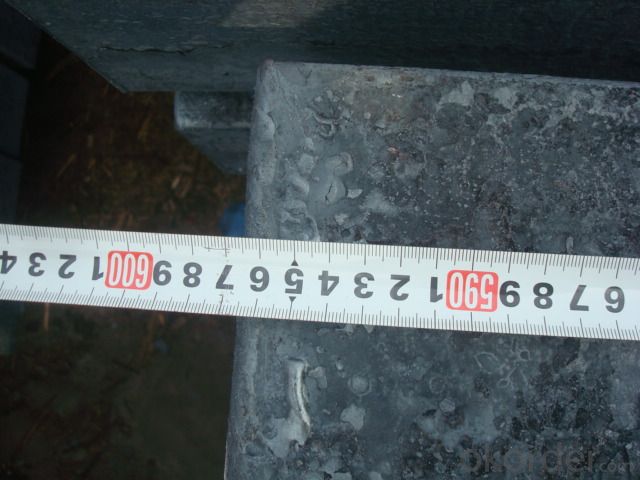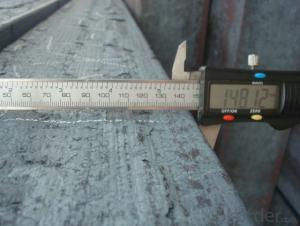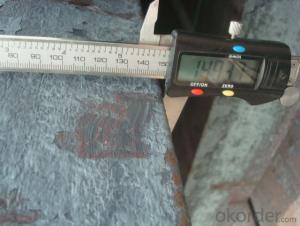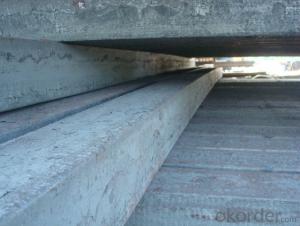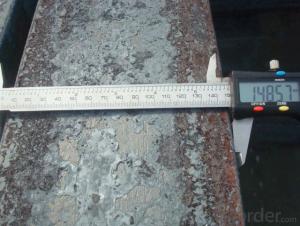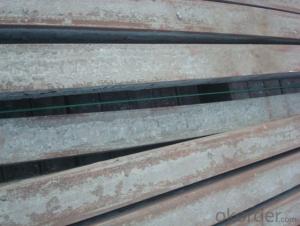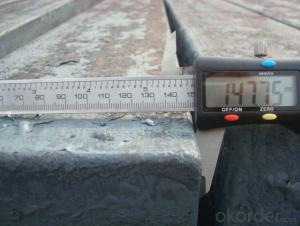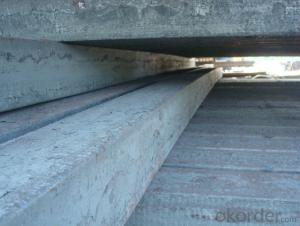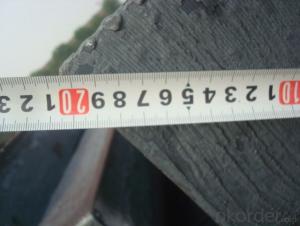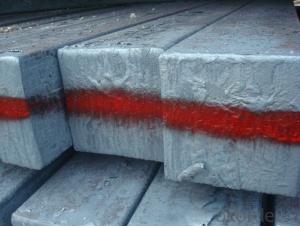Alloyed Steel Billets and Blooms Manufactured by Continue Casting
- Loading Port:
- Tianjin
- Payment Terms:
- TT OR LC
- Min Order Qty:
- 1000 m.t.
- Supply Capability:
- 10000 m.t./month
OKorder Service Pledge
OKorder Financial Service
You Might Also Like
Alloyed Steel Billets and Blooms Manufactured by Continue Casting
1.Structure of Alloyed Steel Billets and Blooms Manufactured by Continue Casting
Steel Billets Manufactured by Continue Casting is the raw material of all kinds of steel mill. Billet section of square, round, flat, rectangular and abnormity, etc Several, mainly related to shape of rolled products. Simple rolled section steel, choose cross section of square billet or rectangular billet. rolling The sector products such as flat steel, Angle steel, select the rectangular billet or slab. Had better profiled billet when production beams, channels, and in rolling process Lines and improve the yield. The raw material of round billet is the production of seamless tube.
2.Main Features of Alloyed Steel Billets and Blooms Manufactured by Continue Casting
There are three shapes of the steel billets: square billet, slab, rectangular billet The Chinese billet, rectangular billet is mainly suitable for rolling hot rolled strip, building reinforced bar, Ordinary wire, high speed wire rod and various small profile. Of the slab are mainly used for rolling plate and hot coil sheet.
3. Alloyed Steel Billets and Blooms Manufactured by Continue CastingImages
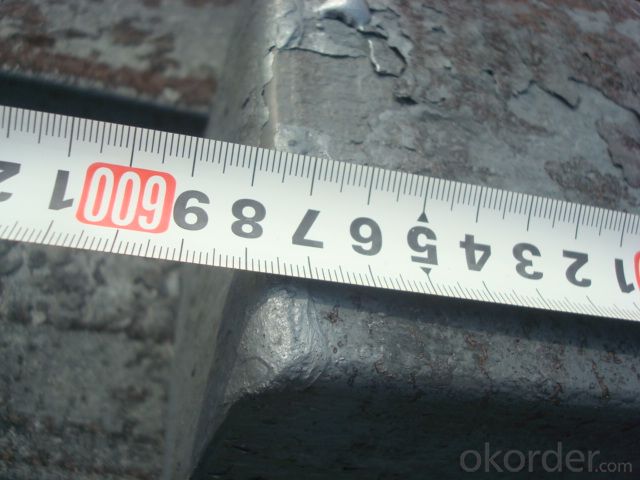
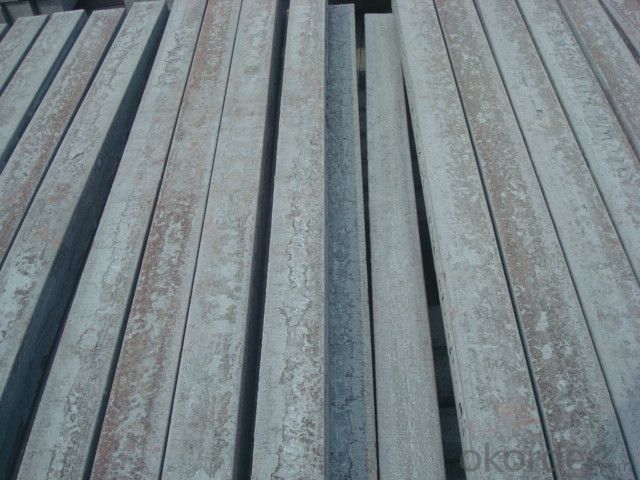
4. Alloyed Steel Billets and Blooms Manufactured by Continue Casting Specification
Steel Billets Manufactured by Continue Casting rolled steel, after processing can be used for mechanical parts, forging parts, processing all kinds of steel, steel Q345B channel steel, wire rod is the role of the billet. Steel billet is used in the production of semi-finished products, generally cannot be used directly for the society. Steel billets and steel are strictly divided into standard, cannot decide to whether the business enterprise of the final product, and according to unified standards to perform the whole society. Typically, billet and the steel is relatively easy to distinguish, but for some steel billet, and have the same specification and same steel purposes (such as rolling tube billet), whether can be used for other industries, whether through steel processing process, whether through a finished product rolling mill processing to distinguish
5.FAQ of Alloyed Steel Billets and Blooms Manufactured by Continue Casting
We have organized several common questions for our clients,may help you sincerely:
①How about your company?
A world class manufacturer & supplier of castings forging in carbon steel and alloy steel,is one of the large-scale professional investment casting production bases in China,consisting of both casting foundry forging and machining factory. Annually more than 8000 tons Precision casting and forging parts are exported to markets in Europe,America and Japan. OEM casting and forging service available according to customer’s requirements.
②How to guarantee the quality of the products?
We have established the international advanced quality management system,every link from raw material to final product we have strict quality test;We resolutely put an end to unqualified products flowing into the market. At the same time, we will provide necessary follow-up service assurance.
Inclusions with the steel flow to lower part of crystallizer, the faster the speed, the deeper the impact.Because of proportion, inclusions have a rise trend.Movement is a steel circular trajectory, and buoyancy (vertical direction) on the synthesis, the impurities to slab inner arc lateral movement, to the solidification front, was captured by thick area.This quality problem, both in billet, round billet, slab casting machine of arc, exist, have to take a variety of methods, such as machine and electromagnetic stirring in the arc, and electromagnetic brake to solve on the slab.Japan's kawasaki steel mills and the Japanese steel pipe water island fushan factory or even change the arc slab casting machine to bend type casting machine, make the period of more than 3 m of vertical section, to facilitate inclusion floatation, for most curved round billet casting machine, a good performance of mold electromagnetic stirring is a must.Rotating force produced by electromagnetic stirring, make the liquid steel in the process of downward, strong circular motion, this kind of games (major) than the steel liquid to produce centrifugal force, the shell compression, while the mixed proportion (light) centripetal movement, gathered together, high temperature of the mixed collection will make particles increases and tends to rise more, avoid the inward arc movement.And the function of electromagnetic rotation force, reduce the liquid steel flow injection impact depth, and conducive to inclusion floatation.
29.According to the influence of finished product processing performance points, inclusion what type? According to the inclusion, plastic deformation can be divided into brittle inclusions inclusions and half plastic inclusions. Brittle inclusions generally refers to those who do not have plastic deformation capacity, complex and simple oxide composite oxides, nitride and notThe deformation of the ball,Dot inclusions.Because the wire is approved by billet hot rolled into wire rod after the drawing and form,For the deformation is large,soA1203And spinel deformation brittle inclusions is very big to the harm of wire rod. Inclusions in steel processing through plastic deformation when have good plasticity, extends along the flow direction of steel slits, belong to itClass hasThe SiO2Low content of iron silicate, iron sulfide, manganese(Fe,Mn) SAnd so on. Half of the plastic inclusions generally refers to all kinds of compound aluminum silicate inclusions. Deformation behavior of non-metallic inclusions in steel is more complex, not only depend on the type of inclusions, and composition and inclusionClosely related to deformation temperature.
③What is the advantage of the continue Casting steel billet comparing to the die casting steel billet?And how is the process?
Compared with die casting, continuous casting has the advantages of: 1. To simplify the Steel billet The production process 2. Improve the metal yield 3. Improve the quality of the billet 4. Reduces the steel worker's labor intensity 5. Save energy and reduce consumption
Steel billet is produced by the method of through three processes: It is through the steelmaking system of continuous casting equipment, directly by the molten steel pouring into billet; The second is the steelmaking system in the production of steel ingot casting billet through system of steel rolling rolling equipment or processing of steel semi-finished products; Three is the steelmaking system production of steel ingot by forging the semi-finished product processing equipment.
- Q: How are steel billets classified based on their chemical composition?
- Steel billets are classified based on their chemical composition primarily into three categories: carbon steel, alloy steel, and stainless steel. Carbon steel contains mainly iron and carbon, with trace amounts of other elements. Alloy steel is a combination of iron with other elements, such as manganese, chromium, nickel, or molybdenum, to enhance its mechanical properties. Stainless steel, on the other hand, contains iron along with a minimum of 10.5% chromium, which provides excellent corrosion resistance.
- Q: How are steel billets manipulated during the manufacturing process?
- Steel billets are manipulated during the manufacturing process through various methods such as heating, rolling, forging, and cutting. Heating the billets makes them more malleable and easier to shape. Rolling involves passing the heated billets through a series of rollers to reduce their thickness and create desired shapes. Forging is another technique where the billets are shaped using compressive forces. Finally, cutting is done to obtain specific lengths or shapes required for further processing or fabrication.
- Q: Can steel billets be recycled?
- Yes, steel billets can be recycled. Steel is a highly recyclable material, and the recycling process for steel billets is relatively straightforward. When steel billets, which are typically produced through a casting process, are no longer needed or have reached the end of their lifecycle, they can be recycled and transformed into new steel products. The recycling process begins with the collection and sorting of the steel billets. They are then transported to a recycling facility where they are melted down in a furnace. Once melted, impurities are removed, and the resulting molten steel is formed into new billets or other steel products through various shaping and casting techniques. Recycling steel billets not only helps to conserve natural resources and reduce waste but also has significant environmental benefits. The recycling process requires less energy and emits fewer greenhouse gases compared to the production of steel from raw materials. Additionally, recycling steel helps to reduce the demand for mining iron ore, which can have detrimental effects on the environment. Overall, steel billets can be effectively recycled, allowing for the sustainable and responsible use of this versatile material.
- Q: What shape is the billet?
- Mainly from the shape of two:Slab: the ratio of section width and height is larger, which is mainly used for rolling plate.Billet: cross section width, height equal, or difference is not big, mainly used for rolling steel, wire.Texture of materialContinuous casting square and rectangular billets are mainly made of plain carbon steel, low carbon and low silicon cold rolled material, high quality carbon structural steel, low alloy high strength steel, special steel and so on.
- Q: Are steel billets susceptible to corrosion?
- Yes, steel billets are susceptible to corrosion.
- Q: How are steel billets used in the manufacturing of industrial compressors?
- Steel billets are crucial in the manufacturing of industrial compressors as they serve as the raw material for forging or machining the various components of the compressors such as cylinders, pistons, and crankshafts. These billets are heated and shaped through different manufacturing processes to create the desired compressor parts, ensuring strength, durability, and high performance in the final product.
- Q: What are the different surface treatments for improved surface hardness in steel billets?
- To enhance the surface hardness of steel billets, there are various surface treatments available. These treatments aim to increase the wear resistance and durability of the steel, making it suitable for a range of industrial uses. One frequently used method is carburizing, which involves exposing the steel billet to a carbon-rich environment, like methane or propane. This process introduces carbon into the surface, creating a hard layer called a case that significantly boosts the billet's surface hardness. Another technique is nitriding, where the steel billet is exposed to a nitrogen-rich atmosphere at elevated temperatures. This causes nitrogen atoms to diffuse into the surface, forming a hard nitride layer. Nitriding not only enhances surface hardness but also improves resistance to wear and corrosion. Induction hardening is a third method that utilizes electromagnetic induction to rapidly heat the steel billet's surface. After reaching the desired temperature, the billet is quickly cooled, resulting in a hardened surface layer. This treatment is especially effective for localized hardening of specific areas. Furthermore, shot peening is a surface treatment that involves bombarding the steel billet's surface with small, high-velocity steel shots. This process induces compressive stresses in the surface layer, thereby increasing hardness and fatigue resistance. Each of these surface treatments comes with its own advantages and disadvantages. The choice of treatment method depends on the specific requirements and intended use of the steel billets. By selecting the appropriate surface treatment, manufacturers can ensure that the steel billets possess the necessary hardness and durability for their intended applications.
- Q: How are steel billets used in the manufacturing of industrial machinery parts?
- Steel billets possess unique properties and versatility, making them indispensable for the production of industrial machinery parts. These semi-finished steel products are typically cast in square or rectangular shapes and serve as the foundational material for critical components like gears, shafts, pistons, and others. To facilitate manipulation and shaping, the first step involves heating the steel billets to a specific temperature. Once heated, they undergo a process known as hot rolling, where they are passed through rollers to decrease their cross-sectional area and increase their length. This not only enhances the steel's strength and durability but also refines its microstructure, resulting in improved mechanical properties. Following hot rolling, further processing takes place through machining operations such as cutting, drilling, milling, and grinding. These operations ensure precise dimensions and specifications required for specific machinery parts, enabling seamless integration into the overall machinery assembly. The high strength, toughness, and resistance to wear and tear of steel billets make them highly sought after in the manufacturing of industrial machinery parts. Their exceptional machinability allows for intricate designs and patterns, ensuring optimal functionality and performance. Additionally, steel billets can be easily welded, enabling the joining of multiple parts to create robust structures. In summary, steel billets play a vital role in the manufacturing of industrial machinery parts. By providing a strong, durable, and versatile starting material, they enable the creation of precise and reliable components essential for the smooth operation of industrial machinery in sectors such as manufacturing, construction, and transportation.
- Q: How many tons of billets does it take to produce a ton of thread steel?
- Domestic steel manufacturers, production rate of about 97%, so probably need 1/97%=1.03 tons.
- Q: What are the different heat treatment processes for steel billets?
- Steel billets can undergo various heat treatment processes, each serving a specific purpose and offering distinct advantages. Among the commonly used processes are annealing, normalizing, quenching, tempering, and case hardening. 1. Annealing: The steel billets are heated to high temperatures and gradually cooled to room temperature. This process aims to reduce hardness, enhance machinability, relieve internal stresses, and refine the grain structure, resulting in a more ductile and less brittle steel. 2. Normalizing: By heating the steel billets above the critical range and cooling them in still air, the normalizing process refines the grain structure, improves mechanical properties and machinability, relieves internal stresses, and achieves uniformity in microstructure. 3. Quenching: Rapid cooling of steel billets is achieved by immersing them in a quenching medium like oil, water, or brine. Quenching transforms the austenite phase into martensite, making the steel harder and more wear-resistant. However, it may introduce residual stresses and the risk of cracking. 4. Tempering: Following quenching, tempering is often performed to reduce brittleness and enhance toughness. The quenched steel is reheated to a lower temperature and held for a specific time period. This process relieves stresses, decreases hardness, and improves ductility without sacrificing too much strength. 5. Case Hardening: This process elevates the surface hardness of steel billets while maintaining a tough and ductile core. Carburizing and nitriding are two common methods of case hardening. Carburizing involves heating the steel in a carbon-rich environment to introduce carbon into the surface. Nitriding, on the other hand, introduces nitrogen to form a hard nitride layer. These processes enhance wear resistance and prolong the lifespan of the steel billets. These heat treatment processes allow manufacturers to customize the properties of steel billets to meet specific application requirements. By carefully selecting and implementing the appropriate process, the resulting steel billets can exhibit a wide range of mechanical properties, including hardness, strength, toughness, and wear resistance.
Send your message to us
Alloyed Steel Billets and Blooms Manufactured by Continue Casting
- Loading Port:
- Tianjin
- Payment Terms:
- TT OR LC
- Min Order Qty:
- 1000 m.t.
- Supply Capability:
- 10000 m.t./month
OKorder Service Pledge
OKorder Financial Service
Similar products
Hot products
Hot Searches
Related keywords
